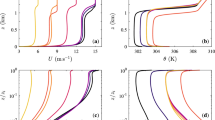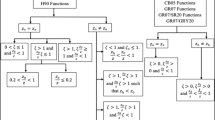Abstract
Based on recent knowledge concerning the vertical structure of turbulence statistics within the roughness sublayer (i.e., the layer directly influenced by individual roughness elements) over urban surfaces the problem of urban-scale dispersion is studied. On this scale it is impossible to resolve each roughness element so that the rough character of the surface has to be taken into account by introducing a roughness sublayer, which is generally not present in dispersion models even when employed in urban environments. Two types of simulations are presented here: one, called `urban’ takes into account the roughness sublayer's turbulence structure, while the other, `non-urban’ does not. A brief overview is given on what changes are required for an `urban' simulation as compared to a `non-urban' or standard dispersion simulation. In particular, a parameterisation is proposed for the vertical profile of Reynolds stress within the roughness sublayer.
Using a Lagrangian stochastic particle dispersion model `urban' and `non-urban' simulations are compared for a variety of boundary-layer states and different source configurations. It is found that neglecting the roughness sublayer results in the largest errors for low source heights and under conditions of mechanically dominated turbulence. This is of particular importance due to the fact that urban surfaces tend to increase the mechanical portion of turbulence and, in addition, low sources, such as traffic and domestic heating, are predominant in urban environments.
On the basis of three tracer data sets from urban release experiments it is shown that, in general, the `urban' simulation improves the model performance yielding smaller fractional bias at the same time as the normalised mean square error is reduced and the correlation to the observations is increased. This indicates that indeed the physical description of the dispersion process is better taken into account in the `urban' simulation. For stable stratification the above statement does not hold true either due to other processes masking the roughness-sublayer influence in this regime or, alternatively, due to a failure of the similarity relations for the turbulence statistics under extremely stable stratification.
Similar content being viewed by others
References
Briggs, G. A.: 1984, ‘Plume Rise and Buoyancy Effects’ in D. Randerson (ed.), Atmospheric Science and Power Production, Tech. Information Center, DOE/ TIC 27601, pp. 327-366.
Clarke, C. F.,Ching, J. K. S., andGodowich, J. M.: 1982, A Study of Turbulence in an Urban Environment, EPA Technical Report, EPA 600-S3-82-062.
Counihan, J.: 1971, ‘Wind Tunnel Determination of the Roughness Length as a Function of the Fetch of Three-Dimensional Roughness Elements’ Atmos. Environ. 5, 637-642.
Du, S.: 1997, ‘Universality of the Lagrangian Velocity Structure Function Constant (Co) Across Different Kinds of Turbulence’ Boundary-Layer Meteorol. 83, 207-219.
Du, S.,Sawford, B. L.,Wilson, J. D., andWilson D. J.: 1995, ‘Estimation of the Kolmogorov Constant (Co) for the Lagrangian Structure Function, Using a Second Order Lagrangian Model of Grid Turbulence’ Phys. Fluids 7, 3083-3090.
Feigenwinter, C.,Vogt, R., andParlow, E.: 1999, ‘Vertical Structure of Selected Turbulence Characteristics above an Urban Canopy’ Theor. Appl. Clim. 62, 51-63.
Grimmond, C. S. B. andOke, T. R.: 1999, ‘Aerodynamic Properties of Urban Areas Derived from Analysis of Surface Form’ J. Appl. Meteorol. 38, 1262-1292.
Gryning, S.-E. andLyck, E.: 1984, ‘Atmospheric Dispersion from Elevated Sources in an Urban Areas: Comparison between Tracer Experiments and Model Calculations’ J. Clim. Appl. Meteorol. 23, 651-660.
de Haan, P.: 1999, ‘On the Use of Density Kernels for Concentration EstimationsWithin Particle and Puff Dispersion Models’ Atmos. Environ. 33, 2007-2021.
de Haan, P. andRotach, M. W.: 1998, ‘A Novel Approach to Atmospheric Dispersion Modelling: The Puff-Particle Model (PPM)’ Quart. J. Roy. Meteorol. Soc. 124, 2771-2792.
de Haan, P.,Rotach, M. W., andWerfeli, M.: 1998, ‘Extension of an Operational Short-Range Dispersion Model for Application in Urban Environments’ Int. J. Vehicle Design 20, 105-114.
de Haan, P.,Rotach, M. W., andWerfeli, M.: 2000, ‘Extension of the OML Dispersion Model to Urban and Near-Source Applications’ J. Appl. Meteorol., in press.
Hanna, S. R: 1982, ‘Applications in Modelling’ in F. T. M. Nieuwstadt andH. van Dop (eds.), Atmospheric Turbulence and Air Pollution, Reidel Publishing Company, Dordrecht, 358 pp.
Hanna, S. R.: 1989, ‘Confidence Limits for Air Quality Model Evaluations, as Estimated by Bootstrap and Jackknife Resampling Methods’ Atmos. Environ. 23, 1385-1398.
Hanna, S. R. andChang, J. C.: 1993, ‘Hybrid Plume Dispersion Model (HPDM). Improvements and Testing at Three Field Sites’ Atmos. Environ. 27A, 1491-1508.
Haugsbakk, I. andTønnesen, D. A.: 1989, Atmospheric Dispersion Experiments at Lillestrøm 1986-1987. Data Report, NILU, OR 41/89.
Heinz, S. andvan Dop, H.: 1999, ‘Buoyant Plume Rise Described by a Lagrangian Turbulence Model’ Atmos. Environ. 33, 2031-2043.
Högström, U.,Bergström, H., andAlexandersson, H.: 1982, ‘Turbulence Characteristics in a Near-Neutrally Stratified Urban Atmosphere’ Boundary-Layer Meteorol. 23, 449-472.
Kono, H.: 1997, ‘Modelling the Dispersion of Motor Vehicle Exhaust Gases, Including Building Effects, and its Application to the Calculation of NOx Concentration in Osaka City’ Int J. Environ. Poll. 8, 620-627.
Kutzbach, J.: 1961, Investigations of theModifications ofWind Profiles by Artificially Controlled Surface Roughness. Studies of the Three-Dimensional Structure of the Planetary Boundary Layer, Annual Report, Dept. of Meteorology, Univ. of Wisconsin, Madison.
Lenschow, D. H.,Zhang, S. F., andStankow, B. B.: 1988, ‘The Stably Stratified Boundary Layer over the Great Plains I: Mean and Turbulence Structure’ Boundary-Layer Meteorol. 42, 95-122.
Luhar, A. L. andBritter, R. E.: 1989, ‘A Random Walk Model for Dispersion in Inhomogeneous Turbulence in a Convective Boundary Layer’ Atmos. Environ. 23, 1911-1924.
Martilli, A.,Clappier, A., andRotach, M. W.: 2000, ‘A Parameterisation of the Urban Effects for Mesoscale Models’ in Preprints of the 3rd Symposium on the Urban Environment, 14-18 August 2000, Davis, CA, pp. 131-132.
Martilli, A.,Clappier, A.,Calpini, B.,Van den Bergh, H., andKrueger, B. C.: 1997, ‘Passive Tracer Studies with the Model CTC for the Athens 2004 Project’ in N. Moussiopoulos andS. Papagrigoriou (eds.), Proceedings of the International Scientific Workshop’ Athens 2004 Air Quality Study, Athens 18/19 February, pp. 83-94.
Nieuwstadt, F. T. M.: 1984, ‘The Turbulence Structure of the Stable Nocturnal Boundary Layer’ J. Atmos. Sci. 41, 2202-2216.
Oikawa, S. andMeng, Y.: 1995, ‘Turbulence Characteristics and Organized Motion in a Suburban Roughness Sublayer’ Boundary-Layer Meteorol. 74, 289-312.
Olesen, H. R.: 1995, ‘The Model Validation Exercise at Mol: Overview of Results’ Int. J. Environ. Poll. 5, 761-784.
Rafailidis, S.: 1997, ‘Influence of Building Areal Density and Roof Shape on the Wind Characteristics Above a Town’ Boundary-Layer Meteorol. 85, 255-271.
Raupach, M. R.,Antonia, R. A., andRajagopalan, S.: 1991, ‘Rough-Wall Turbulent Boundary Layers’ Appl. Mech. Rev. 44, 1-25.
Rotach, M. W.: 1991, Turbulence within and above an Urban Canopy, ETH Diss. 9439, 240 pp., Published as ZGS, Heft 45, Verlag GIETH, Zürich.
Rotach, M. W.: 1993a, ‘Turbulence Close to a Rough Urban Surface Part I: Reynolds Stress’ Boundary-Layer Meteorol. 65, 1-28.
Rotach, M. W.: 1993b, ‘Turbulence Close to a Rough Urban Surface Part II: Variances and Gradients’ Boundary-Layer Meteorol. 66, 75-92.
Rotach, M. W.: 1994, ‘Determination of the Zero Plane Displacement in an Urban Environment’ Boundary-Layer Meteorol. 67, 187-193.
Rotach, M. W.: 1995, ‘Profiles of Turbulence Statistics in and above an Urban Street Canyon’ Atmos. Environ. 29, 1473-1486.
Rotach M. W.: 1997a, ‘The Turbulence Structure in an Urban Roughness Sublayer’ in R. J. Perkins andS. E. Belcher (eds.), Flow and Dispersion through on Groups of Obstacles, Clarendon Press, Oxford, pp. 143-155.
Rotach, M. W.: 1997b, ‘Towards a Meteorological Preprocessor for Dispersion Models in an Urban Environment’ Int J. Environ. Poll. 8, 548-556.
Rotach, M. W.: 1997c, ‘The Effect of Urban Roughness Sublayer Turbulence on Dispersion’ in Preprints 12th Symposium on Boundary Layers and Turbulence, July 28-August 1, 1997, Vancouver, BC, Canada, pp. 453-454.
Rotach, M. W.: 1999, ‘On the Urban Roughness Sublayer’ Atmos. Environ. 33, 4001-4008.
Rotach, M. W. andde Haan, P.: 1997, ‘On the Urban Aspect of the Copenhagen Data Set’ Int J. Environ. Poll. 8, 279-286.
Rotach M. W.,Gryning, S. E., andTassone C.: 1996, ‘A Two-Dimensional Stochastic Lagrangian Dispersion Model for Daytime Conditions’ Quart. J. Roy. Meteorol. Soc. 122, 367-389.
Roth, M.: 2000, ‘Review of Atmospheric Turbulence over Cities’ Quart. J. Roy. Meteorol. Soc. 126, 1941-1990
Roth, M. andOke, T. R.: 1993, ‘Turbulent Transfer Relationships over an Urban Surface. I: Spectral Characteristics’ Quart. J. Roy. Meteorol. Soc. 119, 1071-1104.
Schayes, G,Thunis, P., andBornstein, R.: 1996, ‘Topographic Vorticity-Mode Mesoscale-B (TVM) Model. Part I: Formulation’ J. Appl. Meteorol. 35, 1815-1823.
Schmid, H. P.: 1997, ‘Experimental Design for Flux Measurements: Matching Scales of Observations and Fluxes’ Agric. For. Meteorol. 87, 179-200.
Sorbjan, Z.: 1986, ‘On Similarity in the Atmospheric Boundary Layer’ Boundary-Layer Meteorol. 34, 377-397.
Tassone, C.,Gryning, S.-E., andRotach, M.W.: 1994, ‘A Random-Walk Model for Atmospheric Dispersion in the Daytime Boundary Layer’ in S. E. Gryning andM. M. Millan (eds.), Air Pollution Modelling and its Application X, NATO, Challenges of Modern Society, Vol. 18, pp. 243-251.
Thomson, D. J.: 1987, ‘Criteria for the Selection of Stochastic Models of Particle Trajectories in Turbulent Flows’ J. Fluid Mech. 180, 529-556.
TRC: 1986, Urban Power Plant Plume Studies, EPRI report EA-5468, EPRI, 3412 Hillview Ave., Palo Alto, CA 94304.
Zilitinkevich, S. S.: 1972, ‘On the Determination of the Height of the Ekman Boundary Layer, Boundary-Layer Meteorol. 3’, 141-145.
Author information
Authors and Affiliations
Rights and permissions
About this article
Cite this article
Rotach, M.W. Simulation Of Urban-Scale Dispersion Using A Lagrangian Stochastic Dispersion Model. Boundary-Layer Meteorology 99, 379–410 (2001). https://doi.org/10.1023/A:1018973813500
Issue Date:
DOI: https://doi.org/10.1023/A:1018973813500




